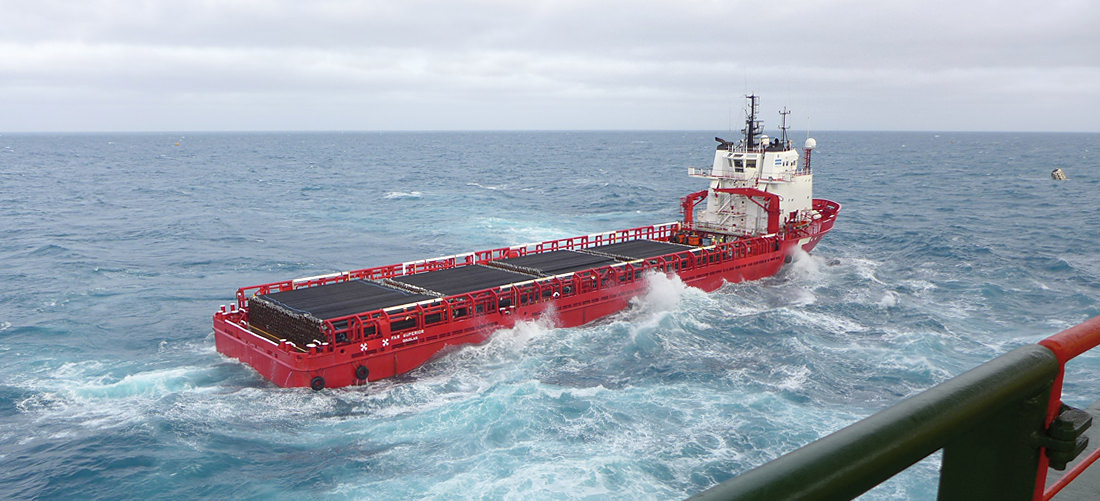HFI-welded steel pipe for offshore pipelines
Trust creates new connections
Whether close to the surface or at ultra-deep depths, whether at low or at high pressures, HFI-welded steel pipe from Salzgitter Mannesmann Line Pipe is used in many and varied applications in offshore projects.
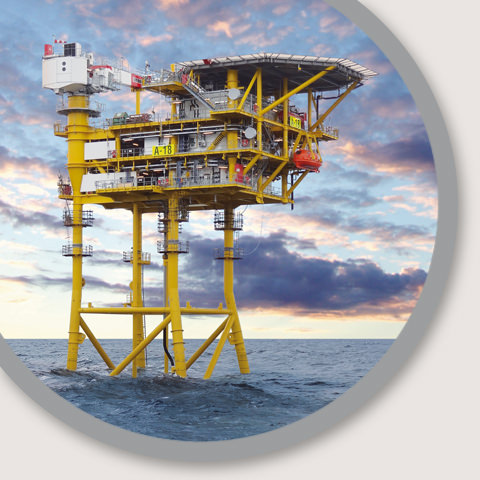
The production platform A18 installed in 2015 in the Dutch North Sea some 300 km off Den Helder
Netherlands I– offshore pipeline for shallow gas
The natural gas fields in blocks A12, A18 and B13 are located some 300 km off Den Helder in the Dutch part of the North Sea. Production from A12 (CPP) and B13 (satellite) started in 2007 and 2011, respectively. A18 is a shallow gas field with a low reservoir pressure of approx. 60 bar.
Onshore connection via A12
In 2015, a satellite platform was installed and put into operation in block A18, in order to exploit the gas reserves from shallow depths around 600 m at a reservoir pressure of approximately 60 bar. So that the gas can be exported to the mainland, operator Petrogas P&E Netherlands BV has laid a 33 km pipeline from A18 to A12 (CPP). Production platform A12 is the central process platform and has the technical infrastructure for processing and compressing the natural gas from A18 and exporting it via the NOGAT pipeline to the Dutch shore.
For the connection pipeline, Salzgitter Mannesmann Line Pipe supplied 33 km of HFI-welded steel pipes of 323.9 x 11.1 mm in grade X60MO steel according to API 5L and customer specifications. The pipes were manufactured at the Hamm plant in the first quarter of 2014 and provided with an HDPE rough coating to the customer's specifications. Before they were delivered to the pipe-laying company Allseas in mid-2015, they were given a heavy coat of concrete at Conline Rhenania in Dordrecht.
Only one meeting needed thanks to excellent communication
Nils Schmidt, who was responsible for the project at Salzgitter Mannesmann Line Pipe: "We were particularly delighted at the customer's interest in the manufacture and further processing of our pipe. And the open atmosphere led to smooth communication right from the start." As all project partners participated in the bid clarification meeting at the Hamm plant on 31 October 2013, it was possible to discuss and clarify all the technical questions. No further meetings were required after that. "The project was a perfect example of what good communication and close interaction between all project partners can achieve, especially when time is at a premium," adds Nils Schmidt.
This became particularly clear when it turned out that pipe bends would be required at short notice. That was where the well-coordinated team of Salzgitter Mannesmann Line Pipe and Salzgitter Mannesmann Grobblech came in once again. Nils Schmidt: "We manufactured 450 m of pipe in 323.9 x 19.1 mm very quickly indeed and forwarded it to Mülheim, where it was induction-bent and dispatched to the customer within five weeks. It certainly wouldn't have been easy to find in a hurry a company that could equal that."
Netherlands II – ONE fully satisfied with initial offshore order
The importance of good interaction among all partners involved is also evident from the following example: Oranje-Nassau Energie B.V. (ONE) is the biggest privately owned oil and gas E&P company in the Netherlands. For its first offshore project, which also involved a pipeline connection between two production platforms in the North Sea, Oranje-Nassau Energie B.V. was looking for a dependable and experienced supplier of steel line pipe.
Long-term "smart" communication
The Dutch engineering office Smart Engineering BV was responsible for all the technical and quality aspects as well as welding procedure tests in the context of the project. From numerous previous offshore projects, a long-standing exchange of ideas and experience has been kept up between Salzgitter Mannesmann Line Pipe und Smart Engineering. Michael Bick from the Technical Customer Service department in Hamm: "We were very familiar with the project requirements and specifications. That certainly gave us a head start in know-how right from the onset."
On the one hand, Salzgitter Mannesmann Line Pipe was able to submit a favorably priced offer, and, on the other, to reserve the necessary capacities within the planned time frame. "The customer was also impressed by the Group-wide supply chain, from the starting material to the finished pipe," says Michael Bick in retrospective.
From Siegen to Hamm and back
The customer ordered a carbon-manganese steel to DIN EN ISO 3183:2012. The 8-inch pipes with a wall thickness of 12.7 mm were manu-factured in Siegen in April 2015 and then transferred to Hamm for a full-body heat treatment to grade L360N FBN steel. Subsequently, they were returned to Siegen to receive a three-layer polypropylene coating, after which they were immediately delivered by truck.
New connections in every sense
The pipeline connects the gas production platforms P11E and P15F in the Dutch part of the North Sea. The laying operations at water depths between 23 and 30 m were entrusted to the Allseas company, which employed its pipe-laying barge "Lorelay" for the project. Girth-welding of the pipes to strings was carried out to a defined qualification program in accordance with the national standard NEN 3650:2012 and ONE specifications.
It was not least owing to excellent communication between all project partners that the work could be carried out and completed within the specified time frame and to the complete satisfaction of all those involved in the project at ONE. Michael Bick in summing up: "We are of course extremely happy to be recommended by long-standing partners who place their trust in our quality and competencies, and when new connections in every sense of the term are created as a result."
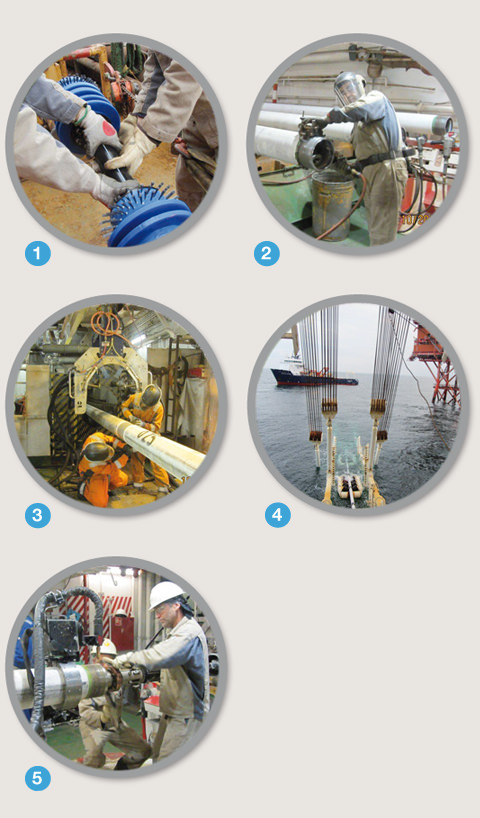
- Brush pig installation
- Installing an earth clamp on 8" pipe
- View onto a stinger
- Cleaning an 8" pipe after shot-blasting
- Cleaning internal shoes
Denmark – high pressure from deepest depths
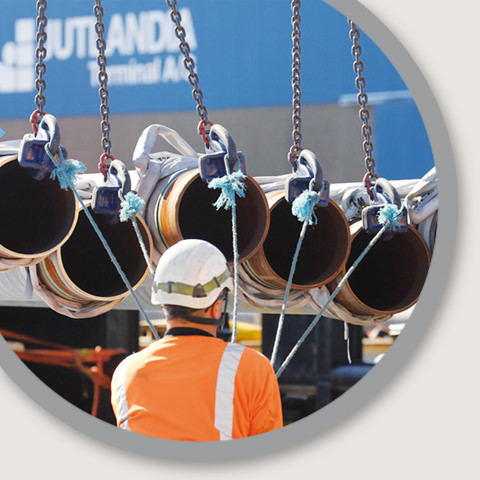
HFI-welded steel pipes being loaded onto a transport vessel.
In 2001, the Hejre oil and gas field was discovered about 290 km northwest of Esbjerg. Further exploration in 2004 and 2005 revealed that total area amounted to some 230 km². The main field covers about 30 km² at a water depth of between five- and six-thousand meters.
Extensive investments
Here, too, the first step was the installation of a production platform. Given the great depth, the reserves are characterized by correspondingly high pressures and temperatures. "Safety first" is therefore the overriding demand through all stages of the project.
To link the new production platform to the existing network, a connecting pipe was laid to the Gorm E platform over a distance of 90 km. For this project, a special pipe-laying barge - the Castoro Sei – was used, on which the pipes are welded into strings and lowered directly into the sea to a depth of approximately 70 m. From the Gorm E platform, the oil produced will be carried via the pipeline to the Fredericia terminal for processing in the new facilities that will be built there.
Time for special ideas – despite a tight time schedule
Following order placement by Saipem Ltd (UK), Salzgitter Mannesmann Line Pipe delivered 93 km of HFI-welded steel pipe in 323.9 x 11.13 mm and and steel grade HFW 450 SD. For external protection, an HDPE rough coat in a special thickness of 3.5 mm was specified.
Nils Schmidt: "To get to grips with the tight time schedule, Saipem Ltd (UK) organized detailed meetings at Salzgitter Mannesmann Line Pipe in Hamm where all open points concerning the project and the project schedule were discussed and settled in good time with representatives from DNV, DONG Energy and Saipem Ltd (UK)."
In addition, several pre-production meetings were held to clarify questions regarding the production and coating of the pipes. Nils Schmidt: “Since everything ran smoothly from the start, we even had enough time to carry out at short notice any extra wishes of the customer. For example, we delivered one pipe with coating windows – that is, a pipe in which specific sections were left uncoated.”
This pipe was used by Saipem for its extensive field coating tests.
Nils Schmidt adds: “Project Manager Dmytro Nalywajko from Saipem UK was available around the clock for our technical questions, coordination of deadlines and deliveries.” His summary: “It was a thoroughly demanding project, but we enjoyed it from beginning to end. And we are happy to have been in it as part of a big team.”
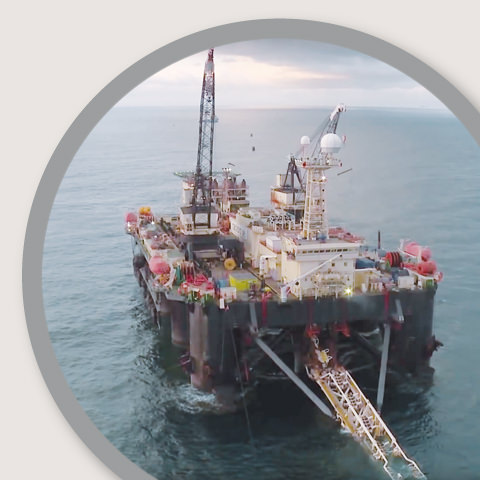
The oil pipeline was laid from the Castoro Sei pipe-laying barge.
